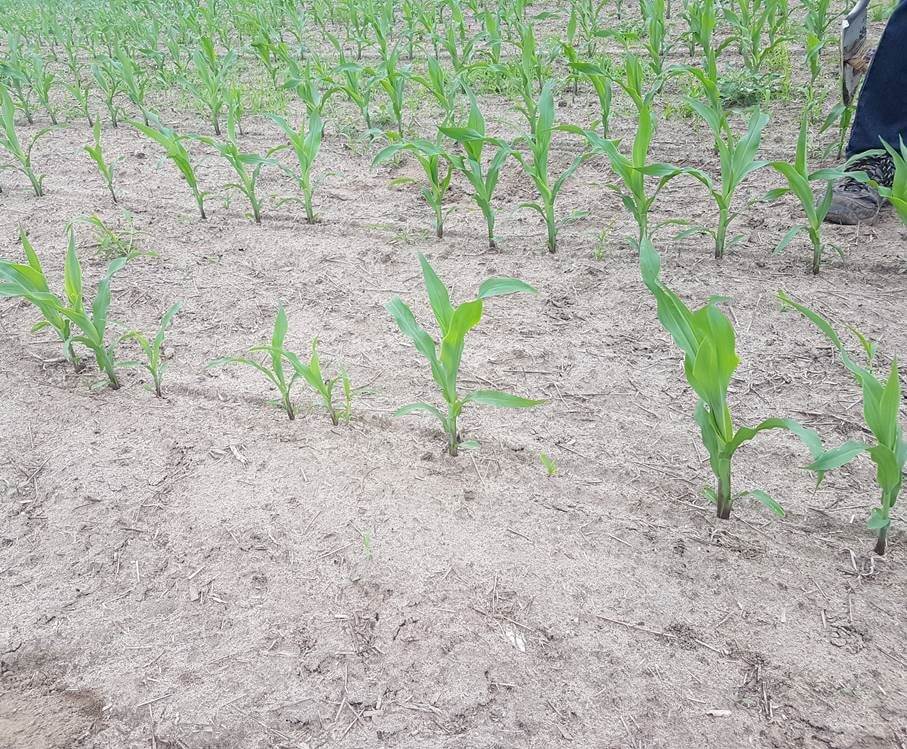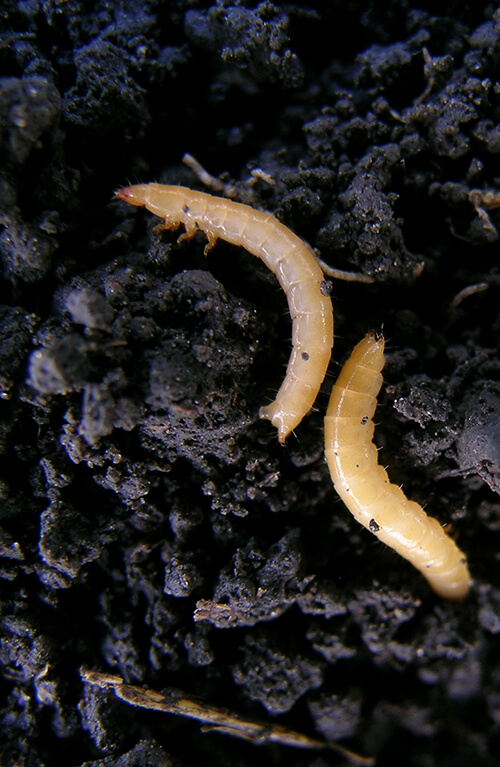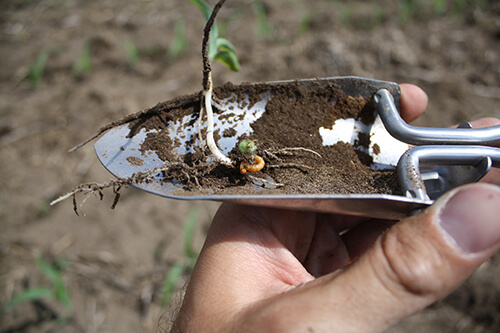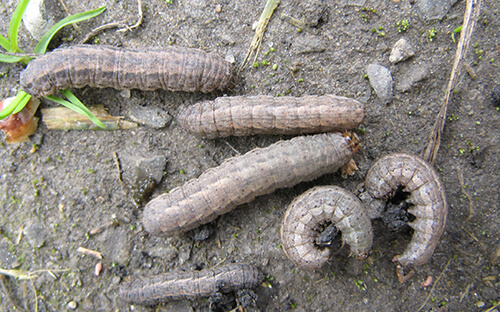Range: Wireworms are widespread in Eastern Canada.1,2
Host crops: Wireworms feed on many crops. In Eastern Canada they cause the most damage to corn and cereal crops.2
Biology: There are many species of wireworm in Eastern Canada and species vary across geographies.
Preferred home: Prevalence of each species in individual fields is influenced by soil type and moisture. However, preferences for certain ecological conditions do not exclude specific species from other areas; it is typical to find multiple species in a single field. The extent of wireworm damage depends on the species present, population density, and larval stage. In general, larger and older larvae cause more damage.3 Heavy wireworm damage is more often associated with sandy or silty soils as opposed to heavy clay soils.2
What does the damage look like? Wireworms damage plants by feeding on seeds and roots, and boring or shredding stems.4 Stunting, wilting, and yellowing of plants could be signs of wireworm feeding. A typical sign of wireworm damage is yellowing and death of the youngest leaf, while the older leaves still appear green. Ultimately, plant death from wireworm feeding reduces plant populations or leads to bare patches in the field (Figures 1 and 2).

Figure 1. Patchy wireworm feeding in corn field.

Figure 2. Corn stand thinned wireworm feeding.
Wireworm damage varies from field-to-field1 and can be sporadic within a field. Wireworms move up and down within the soil according to temperature, moisture (they prefer cool, moist soil) and food source. They are attracted to carbon dioxide released from germinating seedlings. For this reason, they are most damaging when they are near the soil surface in spring. Wireworms may not move very far laterally within the field resulting in patchy feeding.4
Identification:
Wireworms are not true worms; they are the larvae of click beetles. They are called wireworms for their wiry shape. They are slender with a jointed, hard body and have three pairs of legs behind the head. Larval length varies depending on species and life-cycle stage, with fully grown wireworms reaching approximately one to four centimetres in length depending on species.4

Figure 3. Wireworms. Photo courtesy of John Gavloski, Manitoba Agriculture and Resource Development.

Figure 4. Wireworms on seedling corn.
Similar Species
Wireworms may be confused with other insects which may be beneficial insects, of little concern, or require different management. It is important to correctly identify these insects. To determine if it is a wireworm, check the legs. Wireworms have three pairs of legs behind the head. Cutworms also have three pairs of legs but unlike wireworm, cutworms have five pairs of prolegs on their abdomens (Figure 5). Stiletto flies (Figure 6), crane flies (Figure 7), seedcorn maggots (Figure 8) may also be confused with wireworm; however, these larvae have no legs. The stiletto fly preys on wireworms and is not a pest.5 Though they can be slender and wiry, centipedes can be differentiated by the many legs they have (Figure 9).

Figure 5. Dingy cutworms with leg-like structures (prolegs) on abdomen.
Photo courtesy of John Gavloski, Manitoba Agriculture and Resource Development.

Figure 6. Stiletto fly larva.
Photo courtesy of John Gavloski, Manitoba Agriculture and Resource Development.

Figure 7. Crane fly larva.
Photo courtesy of John Gavloski, Manitoba Agriculture and Resource Development.

Figure 8. Seedcorn maggot.
Photo courtesy of John Gavloski, Manitoba Agriculture and Resource Development.

Figure 9. Wireworm (left) and centipede (right).
Photo courtesy of John Gavloski, Manitoba Agriculture and Resource Development.
Life cycle
Wireworms typically live two to six years in the soil, but each species’ lifecycle differs.1 Most of their life is spent as larvae which do the most feeding damage, especially at the later instar stages. Larvae move up and down the soil profile as the temperature and moisture changes, preferring cool, moist soil. They are most active near the soil surface (where they can cause the most crop damage) when soil temperatures are between 10 and 26oC.2 Multiple generations of wireworm can be found in the same field.4
Monitoring
Know your field cropping history, especially if planting a susceptible crop, and scout in spring with plant stand counts, looking for thin or bare patches and damaged seedlings. Dig around these areas to look for wireworms. Bait traps can also be used to help determine if wireworms are present in the field. It is best to set these in the spring (or prior to frost in the fall) when wireworms are typically near the soil surface. There are variations between the bait traps recommended but all share the common recommendation of using a food source and a container. This could include wetted wheat or corn seed, or oatmeal balls in an onion bag or nylon stocking. Bury the traps 10 to 15 centimetres deep and mark the locations so you can return and dig them up 10 to 14 days later. Since wireworm populations can be patchy within a field, place the traps where they are most likely to be present such as areas where previous crops have had low plant stand or bare patches. Using multiple traps is also a good idea. It is important to note that wireworms may not be attracted to the bait ball if other food sources exist. This means that wireworms may be present in a field even if they are not found in the traps.
Economic threshold
There are thresholds established for specific wireworm species in Quebec. For Hypnoidu sabbreviatus, the most common species, the economic intervention threshold is three larvae per bait trap. In cases where other wireworm species are found, the threshold is one larva per bait trap.7
Management
Crop establishment - Promote vigorous, rapid crop growth and stand establishment with proper seed placement into warm, moist soil, with adequate soil fertility and higher seeding rates.2
Crop rotation - Avoid growing multiple corn or cereal crops back-to-back. Control grassy weeds in rotational crops. Flax and buckwheat are often not attacked by wireworms, and pulses and soybean typically sustain much less damage. Fall seeded cereals growing vigorously in spring may outgrow wireworm feeding but could be at risk when germinating in the fall. Long term forages may increase the risk of wireworm damage in the following corn crop. There is much more to be understood about how crop rotation impacts wireworm damage.2,4
Seed treatment-- if wireworms are present then a seed treatment may be a good option for managing them. Discuss options for management with a local crops specialist or supplier and follow local regulations when using seed treatment.
Sources
1 Centre de recherche sur les grains. 2014. Guide des ravageurs de sol. Pp. 48-50. https://cerom.qc.ca/domaines-de-recherche/entomologie/publications.html.
2 Ontario Ministry of Agriculture, Food and Rural Affairs. 2017. Agronomy guide for field crops publication 811.
3 van Herk, W.G., Vernon, R.S., 2014. Click beetles and wireworms (Coleoptera: Elateridae) of Alberta, Saskatchewan, and Manitoba. Arthropods of Canadian Grasslands (Vol 4): Biodiversity and Systematics part 2. pp 87-117. Biological Survey of Canada.
4 Alberta Government. 2014. AgriFacts: wireworm. https://open.alberta.ca/dataset/7179888
5 Manitoba Agriculture and Resource Development. Wireworms on crops in the Canadian prairies. https://www.gov.mb.ca/agriculture/crops/insects/wireworms.html.
6 Gavloski, J., Meers, S., 2011. Arthropods of cereal crops. Arthropods of Canadian Grasslands (Vol 2): Inhabitants of a Changing Landscape. pp 218-219. Biological Survey of Canada.
7 Centre de recherche sur les grains inc. 2017. Guide d’identification des vers fil-de-fer dans les grandes cultures au Quebec. Pp. 37. https://www.agrireseau.net/grandescultures/documents/95825/guide-d_identification-des-vers-fil-de-fer-dans-les-grandes-cultures-au-quebec?a=1&sort=2&r=wireworms.
Legal Statements
Legal Statements
Performance may vary from location to location and from year to year, as local growing, soil and weather conditions may vary. Growers should evaluate data from multiple locations and years whenever possible and should consider the impacts of these conditions on the grower’s fields.
©2021 Bayer Group. All rights reserved. 4019_S1_CA